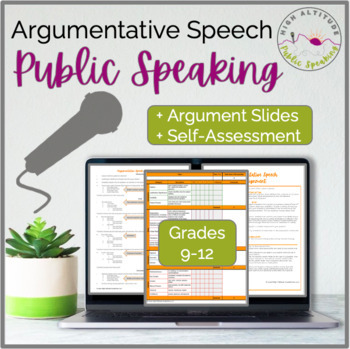PUBLIC SPEAKING Argumentative Speech + Lecture & Self-Assessment | Argument
- Google Drive™ folder

Products in this Bundle (3)
Description
Looking for an argumentative speaking unit plan for high school students that is engaging and easy to implement? This structured argument speech helps students develop a critical level of public speaking confidence. Students select topics for the argumentative speech according to problems they've experienced and their peers experience, and then they follow Monroe's Motivated Sequence to convince their audience to implement a solution.
This comprehensive unit provides secondary ELA/English and public speaking instructors with all of the tools they need to successfully teach the argumentative speech. From the auto-calculating teacher evaluation rubrics and guided argumentative speech outline templates to the peer feedback process, this unit is designed to make teaching easier and learning more fun.
What's included:
- Argumentative Speech Instructions/Assignment
- Skeleton Outline for the Argumentative Speech with Tips for Reference
- Skeleton Outline Google Doc
- Teacher Evaluation Rubrics (Color and B/W) - Auto Calculating
- Peer Feedback Instructions and Rank/Comment Doc
- Lecture Slides (48) for Argumentative Presentations
- Post Delivery Speaker Self-Assessment for Argumentative Speech
Basic Steps:
- Deliver the argumentative speech lecture.
- Review the argumentative speech topic and assignment instructions.
- Students research their proposals and create their preparation outlines.
- Students practice with their preparation outlines and then create their speaking outlines by removing all unnecessary words and adding delivery cues.
- Students practice with their speaking outlines.
- Students deliver speeches while teachers evaluate their presentations and peers provide feedback.
- Students complete the self-assessment after they speak.
Students learn a lot about structured argument, and they develop a critical level of public speaking confidence through this argumentative speech experience.
ASSIGNMENT and OUTLINES: Unit includes an instruction sheet and skeleton outlines that will help public speaking students draft cohesive, developed presentations. Materials may be printed, added directly to Google Classroom, or saved as Microsoft PPT, Word, and Excel files.
TEACHER EVALUATION: Speech teachers know that fair speaker evaluations require focus and efficiency. It's not easy! With this efficient Google Sheet, teachers can provide meaningful and timely feedback for student speakers. This process is so streamlined that teachers can easily score key elements of content and delivery, add guidance for growth, note areas of strength, and "Return" the evaluation to the speaker through Google Classroom---all within seconds of the speech conclusion. Include a numerical rating for each category/skill, add succinct comments, and click "Return." When the speaker is finished, the teacher is finished! The cell formulas do the calculating. Use the completed Google Sheet to easily conference with students regarding their speaking experience.
PEER FEEDBACK: Providing feedback to a public speaker is a weighty responsibility.
- It requires focus.
- It requires maturity.
- It requires tact.
As students work through the peer feedback process, they'll help their classmates hone their public speaking skills while they learn more about effective speech delivery.
Speech students have as much to learn from each other as they do from their teachers. Students who complete the peer feedback process will become skilled speakers more quickly because they're not just observing a speech; they're evaluating the information, the organization, and the delivery.
Because I know that peer feedback can be difficult to manage, I've written instructions that address the peer feedback process, including considerations about motivation, careful phrasing and the goal of peer evaluation.
ARGUMENTATIVE SPEECH SLIDESHOW LECTURE: This slideshow lecture makes it SO easy for teachers to provide secondary students with essential background for Argumentative presentations. Slides are designed to make information accessible for speech students, and they're grouped by five main ideas:
- Purpose
- Topic
- Process
- Organization
- Considerations
POST DELIVERY SPEAKER SELF-ASSESSMENT: Simply "assign" the Google Sheet through Google Classroom. Remember to select "Make a copy for each student" when you create the assignment. The Google Sheet includes the following sections:
- Written Preparation
- Delivery Practice
- Speaking Experience
- Habits of Work
- Planning.
CHECK OUT THIS "PERFECT PAIRING":
Related Products
⭐ Demonstration How to Speech + Lecture and Self-Assessment
Related Products
⭐ PUBLIC SPEAKING Problem/Solution Persuasive Speech + Student Self-Assessment
LIKE MY CREATIONS?
I'd love to have you follow me!
INTERESTED IN MORE TEACHING RESOURCES?
Shop my store: High Altitude Academics. Thank you so much!
ARTIST CREDITS:
"The artwork used is licensed by Sniggle Sloth."





